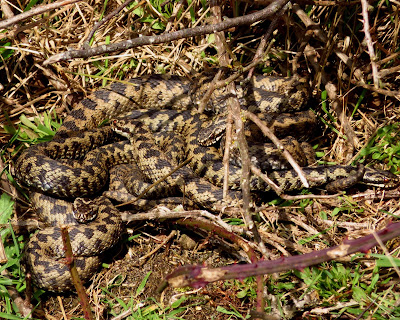Check out the newly produced film about the wildlife of Mersea Island filmed by Mat Larkin during 2014 and 2015.
It can be viewed at - https://www.youtube.com/watch?v=vL4o0vUlkxI&feature=youtu.be;
It's a great piece of work showcasing all the main wildlife features and scenes on the Island in the course of 12 months. I know Mat put in many hours on Mersea gathering lots of footage and it has certainly paid off with this stunning wildlife documentary, capturing the drama, the spectacle and the moods perfectly.
A red kite was seen flying west over the car park at the country park by Neil Mortimer in the morning of Friday 25th. Like all the other red kite sightings at the park over recent years, it didn't hang around.
At the park pond pictured above, the Cetti's warbler was heard singing but not seen, the green woodpeckers continue to yaffle loudly and chase each other around but no sound from the chiffchaff at the back of the pond.
At West Mersea a common buzzard flew high over Firs Chase westwards towards Old Hall Marshes near noon while earlier 15 redwing stopped off at the tops of trees in nearby gardens.
Along the Strood seawall, a snipe, reed bunting, 10 linnets and kestrel were noted.
A pair of stock doves didn't take long to check out this recently erected barn owl nestbox near the back of the pond. Less than 24 hours after it was put up on Wednesday 23rd, the stock doves were perching on it the next day and again on Friday. The other stock dove pair occupying the nearby little owl box are being harassed by a pair of jackdaws, also interested in using the box.
On Thursday 24th at the park pond, there was a singing chiffchaff, pair of pochard, siskin in the alders, 5 little egrets, 3 green woodpeckers and 15 redwing flying over.
On the nearby fields a common sandpiper and avocet were seen in the fields by Pete Dwyer and friends who also reported a stonechat along the seawall. Later four snipe, 100 golden plover and 500 wigeon were seen.
A kingfisher was seen by Martin Cock at the Oyster Fishery on Thursday and also 12 redwings in a horse paddock to the north of the park.
A tawny owl nestbox was installed on Wednesday up an oak tree on the east side of the copse behind the park pond , viewable from the path alongside the pools on the grazing fields. It's maybe a bit late this season for any tawny to nest here but they were regular in this area up until 6 or 7 years ago when they used to nest in nearby Bromans Lane.
Thanks to Andy Field for the help in installing both the owl boxes.
The chiffchaff was singing loudly beside us on Wednesday, as were a couple of goldcrests and we even glimpsed the Cetti's warbler. A siskin and grey heron were noted here too.
High over the park on the sunny Wednesday were four common buzzards, one a displaying male also a large female both seen dropping back down to the Shop Lane area. Also a pair of sparrowhawks seen high to the north of the park and the pair of kestrels by their usual tree at the back of the fields.
Four adders have been enjoying the sunshine at the park in recent days as was a peacock butterfly resting on the ground just a few inches from one of the adders.
In West Mersea a comma butterfly was reported in the East Road garden of Adrian Amos on Friday.
The moth trap was set up at the park on both Tuesday and Wednesday nights with typical numbers of early spring moths noted, 60 individuals on the first night and 44 on the second night.
This oak beauty was the largest and most striking moth noted over the two nights.
This twin-spotted quaker was in the trap on the Wednesday morning among lots of common quakers and Hebrew characters.
Just one grey shoulder knot was seen, pictured above, an annual visitor in early spring. Other moths noted were clouded drab and March moth.

















































